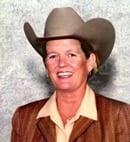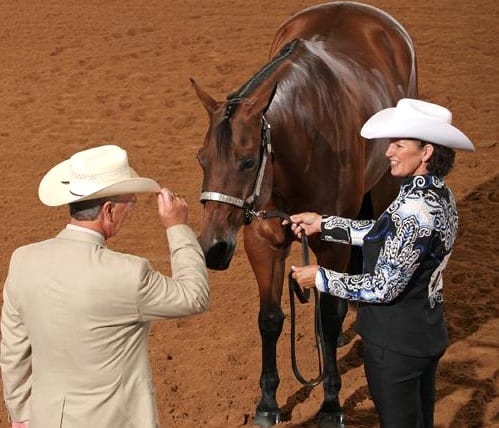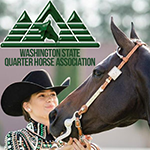If you could give one piece of advice
to someone showing in showmanship, what would it be? How much do you penalize a horse picking up its pivot foot? What sets
your winner apart from the rest? GoHorseShow.com asked a group of well respected judges these questions and more regarding one of the most subjective classes, Showmanship.
We talked to AQHA judge Beckey Schooler whose client, Samantha Chiodo just won the AQHYA World Show in the Showmanship with Ima Natural Detail. Additionally, we interviewed AQHA judges Charlene Carter, Brent Maxwell and Holly Hover who have each helped several clients succeed on the national level in this often challenging and difficult class.
Question #1–What is your biggest pet peeve with regards to this class?
 Brent Maxwell—My biggest pet peeve is the “squat trot.” I find it to be extremely unnatural and quite humorous!
Brent Maxwell—My biggest pet peeve is the “squat trot.” I find it to be extremely unnatural and quite humorous!
 Beckey Schooler–My biggest pet peeve is when exhibitors in the showmanship have their arms down and are constantly pulling down on the chain after each maneuver. I consider that schooling and they are automatically out in my book.
Beckey Schooler–My biggest pet peeve is when exhibitors in the showmanship have their arms down and are constantly pulling down on the chain after each maneuver. I consider that schooling and they are automatically out in my book.
 Holly Hover–When competitors show a very animated way of running. It is one of the difficulties I have as a judge–especially if the showman does everything else correctly. I don’t want to reward this “gimmicky” look but at the same time I don’t want to penalize them too harshly. Also, exhibitors need to be aware that judges are watching the warm up pen and if we see someone jerking and whipping their horse before or after the class–they may be severely penalized. Also, the exhibitor needs to continue showing to the very end because you shouldn’t give anything away. If you tell us you didn’t do well by your body language, then that may be taken into consideration when we are marking down your score.
Holly Hover–When competitors show a very animated way of running. It is one of the difficulties I have as a judge–especially if the showman does everything else correctly. I don’t want to reward this “gimmicky” look but at the same time I don’t want to penalize them too harshly. Also, exhibitors need to be aware that judges are watching the warm up pen and if we see someone jerking and whipping their horse before or after the class–they may be severely penalized. Also, the exhibitor needs to continue showing to the very end because you shouldn’t give anything away. If you tell us you didn’t do well by your body language, then that may be taken into consideration when we are marking down your score.
 Charlene Carter––During the inspection–when the exhibitor crosses over in a bouncy and artificial fashion–that is not credit earning. Also, it is not a good look when some people dip their head down on their crossovers. Also, when they stand and present, they do not need to lean back and arch their back where their shoulders are behind their hips. There needs to be a straight line from their shoulders to their hip to their heel. Their back needs to be flat like they are standing against a wall. Their shoulders and their toes need to be going in the same direction and they should not break in the middle.
Charlene Carter––During the inspection–when the exhibitor crosses over in a bouncy and artificial fashion–that is not credit earning. Also, it is not a good look when some people dip their head down on their crossovers. Also, when they stand and present, they do not need to lean back and arch their back where their shoulders are behind their hips. There needs to be a straight line from their shoulders to their hip to their heel. Their back needs to be flat like they are standing against a wall. Their shoulders and their toes need to be going in the same direction and they should not break in the middle.
Question #2–What sets your winner apart from the rest?
Holly Hover—They must have confidence and also perform an accurate pattern.
Beckey Schooler—The one thing that sets my winner apart is when they move with style and grace.
Brent Maxwell–Style, presence, and accuracy
Becky Schooler–As far as the set up, it is also not a speed contest and you must take the time to set it up correctly even if it takes the competitor a little extra time. It is supposed to be like a halter class where you are presenting the horse to the judge, so you need to present the horse to the best of your ability.
Charlene Carter–If it takes a showman slightly longer to achieve perfection in the set up, I don’t consider it a major fault, but it depends on how other people do in the class and I score it accordingly.
Holly Hover— It has to be scored according to degree of difficulty. I would say the longest the set up should take is between three to five seconds. Three seconds in the regular classes and up to five seconds in the novice. The set up needs to be correct foremost and that perfection should not be sacrificed for speed.
Question #4–How do you penalize a horse that moves his pivot foot?
Brent Maxwell—Regarding the pivot foot, we must keep in mind that this is only one maneuver in the pattern but I will score the maneuver as a major fault. So, an excellent exhibitor that may have marked in the 90’s would receive a score in the 60’s. This score still may place at an average weekend show but at shows such as the Congress or World Shows, this error should keep you from winning a ribbon.
Beckey Schooler–-If the horse slides his foot a bit that would not be a big fault in my book, but if they have a huge step out–that would be a major fault.
Charlene Carter–According to the rules, moving the pivot foot is a major fault in the showmanship. They really need to stick it to place high on my card, especially at the big shows. Also, I like when they glance down at the pivot foot because their horse’s foot is telling them how they need to proceed–whether they need to pull them slightly forward or push them back to keep them in a correct position.
Holly Hover—The judges scoring sheets are a work in progress but moving the pivot foot is a mistake and should be scored accordingly. The judge should be able to tell whether the horse made a misstep or whether they are just readjusting their foot to position it for comfort and to protect their soundness.
Question #5–Do you mind if the exhibitor nods their head at the beginning or end of the pattern?
Holly Hover—It is okay at the beginning of the pattern but please don’t nod at the end, especially when you haven’t even finished the pattern. I see some people that are nodding before they finish their last maneuver. It is distracting and not appropriate.
Beckey Schooler—I don’t mind if the exhibitor nods at the beginning of the pattern but do not look back when you finish your pattern. If you do that, to me, you are asking me if you did okay. Be confident and just leave when you are done.
Charlene Carter—I don’t mind it in the beginning of the pattern but do NOT look back at the end of the pattern, especially if you are trotting away—that is extremely dangerous and not necessary.
Brent Maxwell–I am not offended when an exhibitor nods at the beginning or end of a pattern. They are just acknowledging a signal from the judge or the ring steward. However, I do not feel it is necessary to nod at the end of a pattern where the judge is behind the exhibitor and they have to contort themselves to make eye contact.
Question #6–Do you find audible cues like persistent kissing, clucking, or “shooshing” during the pattern annoying?
Brent Maxwell–A good showmanship horse will respond to an exhibitors body position but subtle cues may be necessary for a departure or increase in speed for example. I do find persistent audible kissing, clucking, or “shooshing” annoying and think it shows the horse’s inability to respond.
Beckey Schooler—Audible cues at the beginning of a pattern to get a horse started is fine but excessive clucking or kissing does not leave an overall good impression.
Charlene Carter–I don’t mind a slight cluck at the beginning of each maneuver and a soft whoa but I hate with a passion when people are clucking, and kissed excessively and very loudly. I put a huge N on my card for, “Noise” and if there are two exhibitors tied and I see that big N–I always put them lower. The class is supposed to be about being a team and connecting with your horse with your body language not with loud audible cues–that tells me the showman is “begging” their horse to do the maneuvers which goes against the main purpose of this class.
Holly Hover–My thoughts are if anything is excessive–it is not a good thing. I don’t like anything that looks overdone. To me excessive audible cues is like a refusal. The horse is not wanting to complete that particular maneuver.
Question#7–What length would you like the chain to be in the Showmanship?
Holly Hover–Same thing as cues, anything excessive is distracting. A long chain is bothersome to me because it flops around–I prefer closer contact with the horse. I prefer a length of chain to be from a person’s thumb to their wrist. Leather chains are also fine if a horse is really sensitive and does not do well with a chin under the chin.
Beckey Schooler—As far as chain length, I’m not a fan of a long draped chain because I think it leads to the horse moving his pivot foot and the person not having as much control.
Charlene Carter–I think it needs to be customized to each horse. The showman needs to find out what is best for their horse. Don’t just buy a chain and assume that length will work. Some horses work better with a shorter length while other prefer a longer chain. You have to practice and try different lengths to discover what works best.
Brent Maxwell–For exhibitors that can show their horses on a looser shank, I prefer that the length come from the leather strap rather than having a long chain. A long chain will swing during the pattern and also has a tendency to slide through the halter during presentation leaving a drooping chain under the chin when the exhibitor lifts their hand. I do not like a fixed chain either, one that is pulled up as tight as it can be without having any links extending from the halter. A good exhibitor knows how many links in the chain are protruding from the halter and wants the same length for every performance. I would say that 2-4 inches of chain would be sufficient. Also for a cleaner look on the halter, I recommend having your chain cut to a length that keeps the chain from being looped back on the halter on the right side of the halter.
Question#8–What are some of your attire likes and dislikes?
Charlene Carter—Personally, I don’t care for suits and men’s ties on women in the showmanship. I like a neat sparkly turned out look. I don’t like black with sorrels and I like a lighter colored hat because it opens up the upper body. The hat needs to be shaped well and up on the sides and if you can’t buy an expensive hat–then just get your hat shaped often so it will maintain it shape. I would recommend people watching some of the girls that win in the class and take pictures of their attire and you can take it to where you get your hat and clothes and show it to them so they have a better idea of the desired look. Also, men really need to make sure their suits fit well and are not too loose. Whatever they choose–it needs to compliment the horse.
Beckey Schooler–One of the biggest attire faults I see in the showmanship is pants that are too short. It takes away from the overall picture. A nice fitted suit with an adequate pant length and hat with a nice shape are two things I look for in the showmanship class.
Brent Maxwell–Trends in fashion constantly change but whatever the trend wear something that defines you and your style. Make sure your clothing fits properly and that your hat is cleaned and shaped. And don’t forget those boots. Keep them polished and clean. Men should make sure that their suits are tailored and fit properly as well. Make sure that your hair is up and not covering your number. Your number should be placed squarely in the center of your back. Don’t put it on the bottom of your jacket. If you do, it looks like you are wearing a license plate!
Holly Hover–What you wear is part of your salesmanship. A well fitted suit with an adequate pant length and a nice shaped hat are a must for me.
Question#9–If you could give one piece of advice to someone showing in showmanship, what would it be?









